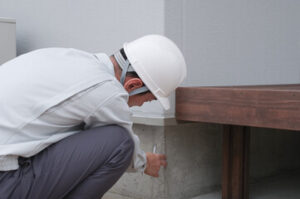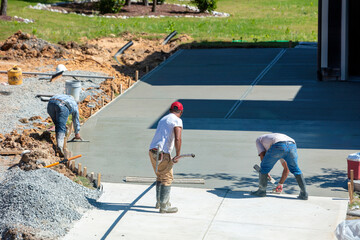Your home’s foundation keeps it standing firm in place and working the way it was designed to. When it becomes weakened, that functionality suffers.
Detecting and addressing problems early is vital for the longevity of your home’s structural integrity. Fortunately, professionals know the right repair methods to fix any issues quickly. Contact Pros Foundation Repair Greensboro NC for professional help.
When cracks in a foundation appear, it’s important to understand what they mean and how serious or minor the damage is. Many cracks are harmless and simply part of the natural settling process of a home or building. However, some cracks indicate significant structural issues that require immediate repair.
Whether the crack is a hairline or wider fissure, it’s important to note any changes over time. If you notice the crack widening, it’s best to contact a professional for an inspection and estimate of repair.
Most cracks occur due to soil movement and expansion, especially when the soil is rich in clay. As the clay swells, it causes pressure on the foundation walls, resulting in cracking. Another cause of these types of cracks is poor drainage around the foundation, which can lead to soaked soil that then puts pressure on the foundation walls.
Other types of cracks include horizontal and diagonal. These are more serious and can signal wall collapse, structural issues, and even flooding. They may also be a result of a shift in ground water pressure, indicating the need for soil replacement.
To fix these cracks, first clean the crack and the area surrounding it to remove any debris. Use a wire brush to get down to bare concrete and then seal the outside of the crack with epoxy or polyurethane injection. Make sure to use an injection kit designed for the type of crack you’re repairing. Inject the epoxy slowly, allowing it to penetrate into the crack for the best results. Once the epoxy cures, cut off the application ports. If the crack is severe, it may be necessary to underpin the foundation with helical or push piers to stabilize and repair it.
Water Invasion
Even the strongest, most solid-looking foundation can be compromised by water intrusion. This common peril can lead to moldy growth and musty odors, rotting wood structural members, sagging floor beams, and a host of other issues above and below ground. The primary source of residential water intrusion is poor drainage, which causes the soil around a home to become saturated. This over-saturation leads to hydrostatic pressure against the walls of a house, which over time can cause wall cracks and bowing.
This type of pressure can also be exacerbated by heavy rainfall, rising groundwater, and other factors like clogged gutters, downspouts that don’t adequately direct water away from the house, improper landscape grading, or broken water or sewer lines. The best way to combat this threat is to regularly check for visible cracks in your foundation. Then, you can call a professional waterproofing company to assess the problem and implement long-term solutions that keep moisture out for good.
While many people can tackle small cracks and other minor repairs themselves, for larger problems it’s important to hire a professional. A professional will be able to identify the root cause of the issue and recommend the appropriate steps to prevent future problems. These may include a drainage system, a crawlspace friendly sump pump, or other strategies. They’ll also use a moisture analysis to track water intrusion throughout your home. This will help them identify other signs of water intrusion, such as a musty odor or fungus growth, so that you can address these issues before they become a big problem. They’ll also be able to recommend long-term strategies that will keep your foundation dry and protect the integrity of your home.
Structural Issues
Structural issues that aren’t addressed promptly can lead to serious damage and collapse. Fortunately, you can often recognize structural problems before they escalate. Symptoms like crevices that widen or lengthen, chimneys pulling away from the home, and doors and windows becoming difficult to open or close may indicate that the foundation is shifting. A professional can recommend effective solutions for these concerns, such as steel shoring or underpinning strategies that steady sinking foundations and ward off the risk of collapse.
Hairline cracks in walls and foundations typically don’t signal a major problem, but they are worth monitoring over time. If they widen, lengthen, or grow beyond their original pencil mark, it is a sign that the underlying cause needs to be dealt with immediately.
Other signs of a failing foundation include floors that are uneven or bouncy and a noticeable slope in the building. These issues can be caused by a settling foundation, soil erosion, or poor construction techniques. Taking measures to keep the crawl space dry, installing dehumidifiers, and amending landscaping to avoid soil compaction are effective preventative strategies.
When a homeowner notices signs of structural failure, they should contact a professional foundation repair expert immediately. A structural specialist can assess the severity of the issue, provide a customized repair plan and cost estimate, and offer recommendations for future maintenance to preserve the property’s integrity. A comprehensive maintenance strategy should also include drainage adjustments to ensure that water is flowing properly and prevent flooding in the area, as well as pest management and masonry repointing services to seal cracks and prevent further damage. A quality contractor will provide clear communication and a warranty on the repairs, providing peace of mind to homeowners.
Uneven Floors
Uneven floors that are sagging, buckling, or slope are often the result of a foundation problem. This issue can come from a variety of causes, including water damage, soil movement, or just age. Regardless of the cause, a sagging floor is a sign of bigger issues and should be addressed right away before they get worse.
The primary reason for uneven floors is excess moisture. This can be caused by leaky pipes, groundwater, or flooding due to seasonal heavy rains. This moisture will cause the wooden beams and sub-flooring to warp, which will in turn misalign the foundation.
Moisture can also cause uneven floors when there is poor drainage around the foundation. This is especially true in climates that experience a range of seasons and weather conditions. The soil will expand when it is wet and shrink when it dries, which can shift the foundation and cause uneven floors.
Building materials don’t last forever and will eventually begin to weaken over time, which can cause the joists and floors to warp. This is why it’s important to inspect any new home you are considering buying for signs of a sagging floor or other structural problems.
Uneven floors can be fixed through various methods depending on the cause of the issue. For example, if the uneven floor is caused by foundation settlement, a repair solution like push piers will be used to lift the sagging joists and level out the floor. Other solutions include using hydraulic jacks to raise the foundation and then stabilizing it with special footing and piers. A full excavation is often required to find the load-bearing soil underneath the foundation and install the piers.
Crawl Space
If your home’s foundation has a crawl space, you may have to deal with moisture issues. Moisture is a major cause of wood rot, mold growth, and other structural damage. This is why proper grading, gutters, and French drain systems are essential to keep water away from your crawl space foundation.
Crawl space foundations require a more extensive maintenance plan than slab foundations. They need ventilation and vapor barriers to regulate humidity levels and prevent mold, pests, and other problems that can occur in damp conditions. They also need regular inspections for signs of leaks, cracks, and other problems. They’re less stable than slab foundations and can be prone to shifts in soil. Crawl spaces aren’t a good choice for homes in areas prone to earthquakes or extreme sloping.
There are several types of crawl space foundations, including pier and beam, block, and brick. All of these have different pros and cons, so you’ll need to choose a type that best meets your needs. For example, pier and beam foundations are built on concrete piers that lift your house off the ground, creating a crawl space underneath. They’re more expensive than slab foundations, but they may be a better option if you live in an area prone to earthquakes or soil instability.
The best way to prevent and detect problems with your foundation is to hire a professional contractor for regular inspections. An experienced and qualified contractor will be able to identify early warning signs, such as uneven floors or sticking doors. Then, they can provide the necessary solutions to restore your home’s integrity and keep it in good working condition. When looking for a contractor, consider their experience, licensing, and insurance.

